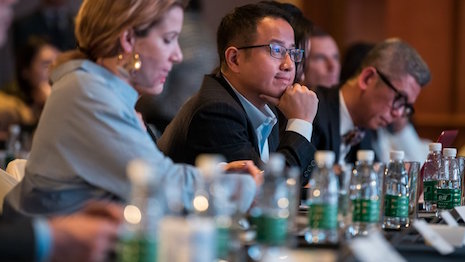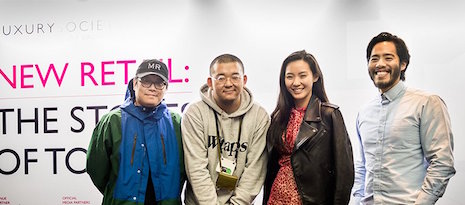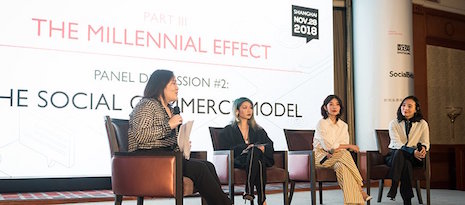 Attendees at the Luxury Society Keynote Shanghai Nov. 28, 2018. Image credit: Luxury Society
Attendees at the Luxury Society Keynote Shanghai Nov. 28, 2018. Image credit: Luxury Society
Representatives from top luxury brands, leaders of industry in digital technology and experts in the field of media, marketing and key opinion leaders converged on the Four Seasons Hotel Shanghai Nov. 28 for the Luxury Society Keynote.
Here are the most important learning points from an afternoon filled with interesting insights in digital strategy and new retail models.
Offline is the new online
As ecommerce continues to grow, especially in China, where much of the country’s rising middle class live in lower-tier cities underpenetrated by luxury retail outlets, physical stores are no less relevant.
Even if sales are not made directly through a physical store, the offline customer experience informs decision-making and delivers the brand DNA.
If luxury brands invest in upgrading their offline stores, and implementing “new retail” concepts, they can complement their online activities, leading to increased customer conversion and retention.
 Kai Hong, chairman and partner at JINGdigital, speaking at Luxury Society Keynote Shanghai. Image credit: Luxury Society
Kai Hong, chairman and partner at JINGdigital, speaking at Luxury Society Keynote Shanghai. Image credit: Luxury Society
“Offline stores have become an integral part of the latest new retail initiatives,” said Kai Hong, chairman and partner at JINGdigital who spoke at the event.
“Offline stores not only contribute a significant portion of transaction, but also provide a unique opportunity for the brands to collect data and build customer intimacy,” he said.
Francis Srun, author of “Luxury Selling,” also spoke during the keynote and agreed that offline points of sale cannot be overlooked.
“Brands have for too long forgotten about the power of influence of their sales advisors,” he said. “Why are sales advisors also called brand ambassadors? They represent a brand, but also defend the brand’s territories.”
 Retail Performance's Francis Srun speaking at the Luxury Society Keynote in Shanghai. Image credit: Luxury Society
Retail Performance's Francis Srun speaking at the Luxury Society Keynote in Shanghai. Image credit: Luxury Society
Target millennials and beyond
It goes without saying that millennials and Generation Z are the future of luxury brands, with both groups forecast to account for more than 40 percent of the luxury goods market by 2025, according to a recent study by Deloitte.
However, when it comes to Chinese Millennials and beyond, luxury brands must not only adapt their marketing strategies for the target age range, but also for cultural sensitivities, tastes and preferences.
 Luxury Society Keynote Shanghai media panelists: From left: Mo Zhao (MYGE), Kidk Xiao (YOHO! Magazine), Tiffany Ap (Women's Wear Daily) and Bryant Chou (Vice China). Image credit: Luxury Society
Luxury Society Keynote Shanghai media panelists: From left: Mo Zhao (MYGE), Kidk Xiao (YOHO! Magazine), Tiffany Ap (Women's Wear Daily) and Bryant Chou (Vice China). Image credit: Luxury Society
Chinese youth have access to information, a wealth of homegrown brands to choose from, and a distinct dislike of feeling patronized by foreign brands.
“Young consumers have experienced an upgrade in consumption in terms of both channels and understanding of luxury products,” said Mo Zhao founder of men's streetwear label MYGE.
“They can very easily get the information about luxury goods,” he said. “Young people do not care about the trends abroad. They are following their own tastes in the Chinese context now.”
Bryant Chou, CEO of Vice China, believes that the localization of international brands is key.
“Although millennials around the world have the same passions, fears, hopes and dreams, there is a different way of talking to them,” he said. “The societal upbringing and what influences them in the world is different.”
The platform to connect with Chinese consumers also varies depending on age.
Adopting the right tone to resonate with the target demographic is important.
“We are multimedia, we have a lot of platforms for people of different ages,” said Kidk, editor in chief of YOHO!
“For young people, we will look at different platforms as we want to keep up,” he said.
Social commerce is about trust
In 2018, influencer-operated WeChat shops grew by 68 percent. The merging of social media and ecommerce is becoming commonplace in the country, with many consumers choosing to put their trust in their favorite online influencer over a brand.
Chinese KOLs have a variety of ways to make money from their social media presence, and a glut of digital platforms to employ.
However, as the panel discussed at the keynote, KOLs must be given the creative freedom by partner brands to produce content that will meet the demands of their followers.
 Social commerce panel at Luxury Society Keynote Shanghai Nov. 28: From left: Doris Wu (Luxury Society), Melilim Fu, Zola Zhang and Fay Li. Image credit: Luxury Society
Social commerce panel at Luxury Society Keynote Shanghai Nov. 28: From left: Doris Wu (Luxury Society), Melilim Fu, Zola Zhang and Fay Li. Image credit: Luxury Society
“Brands need to accept decentralization to allow KOLs to be agile,” said panelist and influencer Fay Li.
Fellow panelist and influencer Zola Zhang agreed.
“We must be allowed to create our own original content,” she said. “To make conversion rates, brands need to trust in the creation of our content.”
 Nyima Pratten
Nyima Pratten
Nyima Pratten has lived in China for eight years and is also Shanghai contributor for Women's Wear Daily.
Reproduced with permission from Luxury Society, a division of Digital Luxury Group. Adapted for style and clarity.
